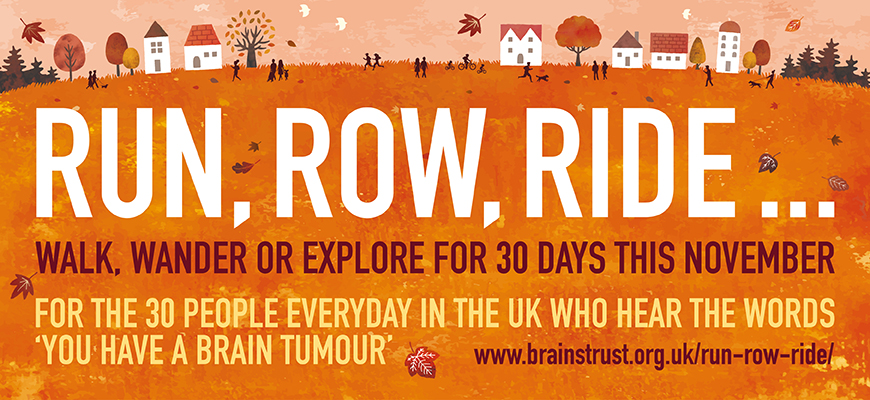Run, Row, Ride is back for 2022
Our famous virtual event Run, Row, Ride will take place once again this coming November!
The challenge is to take on 30 miles over 30 days, all in support of the 30 people who are diagnosed with a brain tumour every day here in the UK.
For those 30 people, the road ahead looks scary and uncertain. By taking part in Run, Row, Ride, you’ll aim to raise £200 to ensure that brainstrust can be here to help families feel less afraid, less alone and more in control.
Run, row ride, walk, wander or explore… do it your way!
Challenging sporting endeavours have always been an exciting part of our fundraising, but we know that for many people such challenges aren’t possible. The impact of a brain tumour diagnosis can often make it impossible to contemplate taking on a long run or walk.
That’s why this year we’ve made Run Row Ride something everyone can get involved with. We’re looking beyond the three R’s and we want to see walkers, wanderers, explorers and more. This is an opportunity for everyone to get involved setting their own challenge, whatever that looks like. It’s also a chance to get together as a community and challenge ourselves to do something new, positive and joyful as we enter the darker, colder months.
Set yourself a 30 day challenge, your way. For example, you could:
- Explore a different street in your neighbourhood each day as you challenge yourself to 30 days of walking
- Challenge yourself to walk a certain number of steps every day, whether that’s just up and down your garden, in the gym, or even around your kitchen
- Focus on the joy of nature, rather than the physical challenge, and set yourself the goal of getting outside to make a new discovery each day
Whether you stay undercover at the gym or explore the great outdoors, your incredible fundraising efforts will support 30 people who have heard the words “you have a brain tumour” today.
Why we’re asking you to get involved
By raising £200, you could help to fund four hours of coaching with one of our dedicated Support Specialists. When life with a brain tumour feels overwhelming, our coaching conversations help people to focus on the things that matter most to them, so they can live their best day, every day.
“Your help has been monumental to me in working through my thoughts and understanding of this disease. You have helped me gain a perspective on what has happened. Thank you so much for all your time and kindness.” – Carer
When you meet or exceed your fantastic fundraising target, we’ll send you a brainstrust medal and certificate to say thank you for your incredible support.
What are you waiting for? Click here to sign up for Run, Row, Ride 2022 now.
For more information please email fundraising@brainstrust.org.uk










